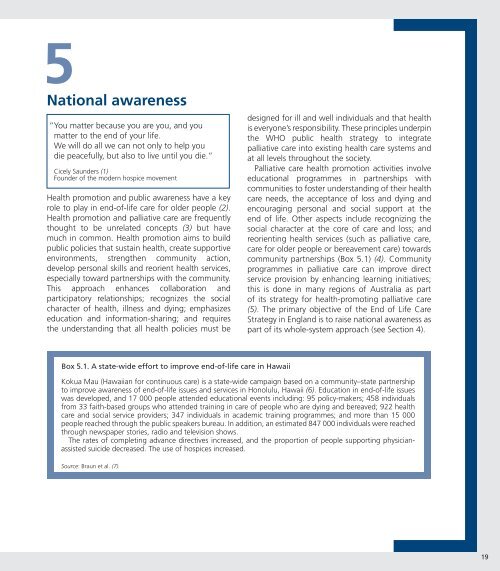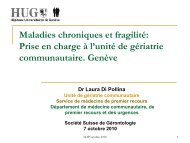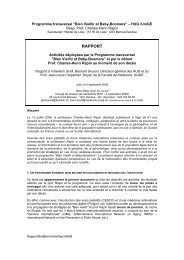Palliative care for older people - World Health Organization ...
Palliative care for older people - World Health Organization ...
Palliative care for older people - World Health Organization ...
You also want an ePaper? Increase the reach of your titles
YUMPU automatically turns print PDFs into web optimized ePapers that Google loves.
5National awareness“You matter because you are you, and youmatter to the end of your life.We will do all we can not only to help youdie peacefully, but also to live until you die.”Cicely Saunders (1)Founder of the modern hospice movement<strong>Health</strong> promotion and public awareness have a keyrole to play in end-of-life <strong>care</strong> <strong>for</strong> <strong>older</strong> <strong>people</strong> (2).<strong>Health</strong> promotion and palliative <strong>care</strong> are frequentlythought to be unrelated concepts (3) but havemuch in common. <strong>Health</strong> promotion aims to buildpublic policies that sustain health, create supportiveenvironments, strengthen community action,develop personal skills and reorient health services,especially toward partnerships with the community.This approach enhances collaboration andparticipatory relationships; recognizes the socialcharacter of health, illness and dying; emphasizeseducation and in<strong>for</strong>mation-sharing; and requiresthe understanding that all health policies must bedesigned <strong>for</strong> ill and well individuals and that healthis everyone’s responsibility. These principles underpinthe WHO public health strategy to integratepalliative <strong>care</strong> into existing health <strong>care</strong> systems andat all levels throughout the society.<strong>Palliative</strong> <strong>care</strong> health promotion activities involveeducational programmes in partnerships withcommunities to foster understanding of their health<strong>care</strong> needs, the acceptance of loss and dying andencouraging personal and social support at theend of life. Other aspects include recognizing thesocial character at the core of <strong>care</strong> and loss; andreorienting health services (such as palliative <strong>care</strong>,<strong>care</strong> <strong>for</strong> <strong>older</strong> <strong>people</strong> or bereavement <strong>care</strong>) towardscommunity partnerships (Box 5.1) (4). Communityprogrammes in palliative <strong>care</strong> can improve directservice provision by enhancing learning initiatives;this is done in many regions of Australia as partof its strategy <strong>for</strong> health-promoting palliative <strong>care</strong>(5). The primary objective of the End of Life CareStrategy in England is to raise national awareness aspart of its whole-system approach (see Section 4).Box 5.1. A state-wide ef<strong>for</strong>t to improve end-of-life <strong>care</strong> in HawaiiKokua Mau (Hawaiian <strong>for</strong> continuous <strong>care</strong>) is a state-wide campaign based on a community–state partnershipto improve awareness of end-of-life issues and services in Honolulu, Hawaii (6). Education in end-of-life issueswas developed, and 17 000 <strong>people</strong> attended educational events including: 95 policy-makers; 458 individualsfrom 33 faith-based groups who attended training in <strong>care</strong> of <strong>people</strong> who are dying and bereaved; 922 health<strong>care</strong> and social service providers; 347 individuals in academic training programmes; and more than 15 000<strong>people</strong> reached through the public speakers bureau. In addition, an estimated 847 000 individuals were reachedthrough newspaper stories, radio and television shows.The rates of completing advance directives increased, and the proportion of <strong>people</strong> supporting physicianassistedsuicide decreased. The use of hospices increased.Source: Braun et al. (7).19
















